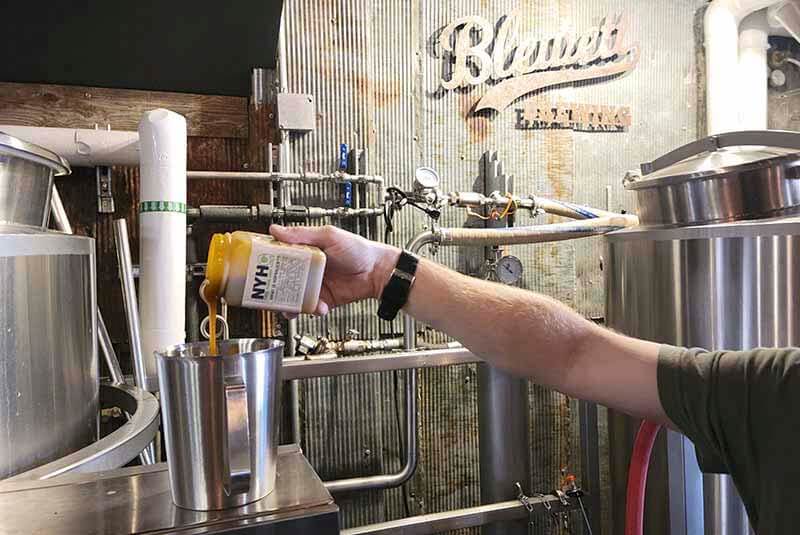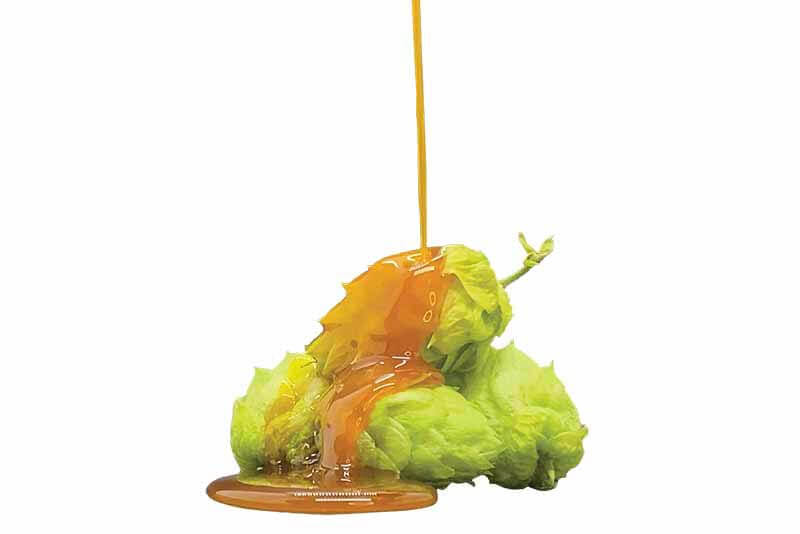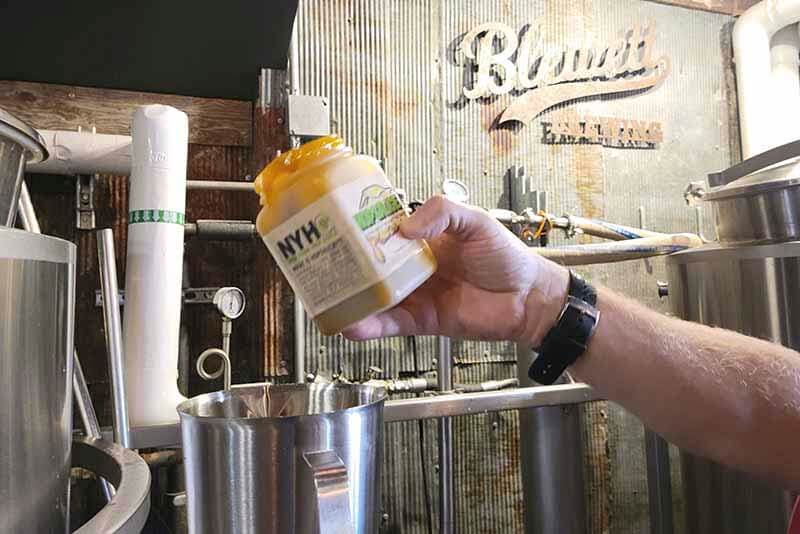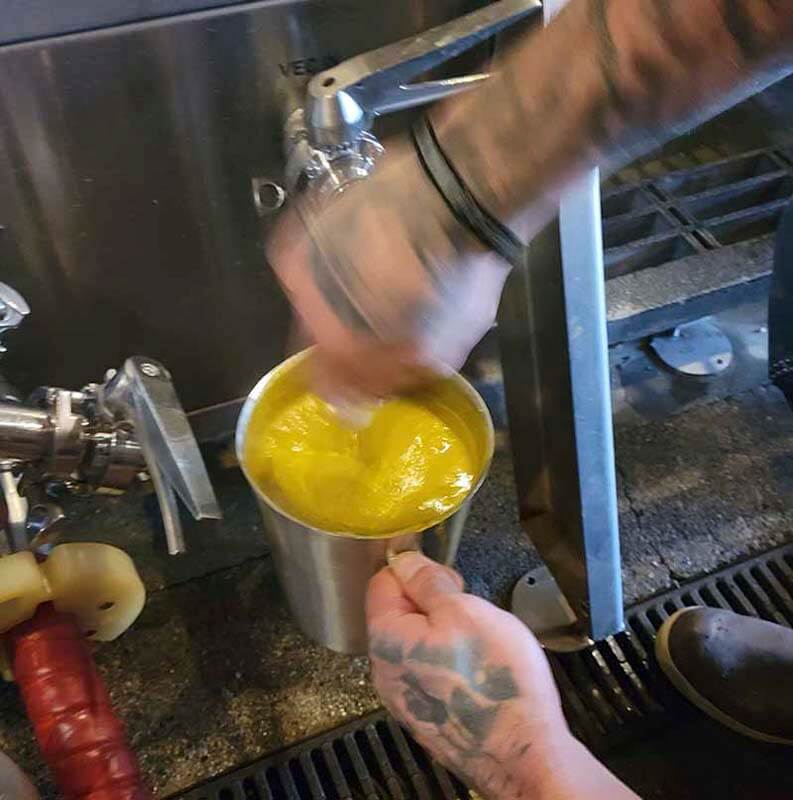
At this point, pretty much every big hop company has come out with their version of a hop product. Such as SPECTRUM from BarthHaas, FLEX® and Incognito from John I. Haas, and SALVO™ from Hopsteiner, to name a few.
When the New York Hop Guild released its own version of a flowable CO2 hop extract, HOPSAUCE™, last July, they seemed to be the first smaller company to get into the game.
“It’s good to work with smaller companies…when you get to actually sit down with the farmer and the manufacturer and brainstorm together about what you can do with the different products,” says Erik Snyder, head brewer at Blewett Brewing Company in Leavenworth, WA, who has already made a couple of beers with HOPSAUCE™.
Because at the end of the day, all these new hop products really boil down to one thing. “Making [good] beer is the whole point right?” says Snyder. “Make beer, drink beer.”
But if you can save a little money and yield along the way while making a better beer thanks to folks willing to sit down with you and make you a part of the process, well that’s almost perfection.
(Above photography courtesy of New York Hop Guild)
What We’ll Cover in This Piece:
Affordable, Industry-Leading Brewery Software
What Is HOPSAUCE™?

Photography courtesy of Blewett Brewing Company
Created by the New York Hop Guild, HOPSAUCE™ is a proprietary CO2 extract engineered for kettle and whirlpool additions to enhance the flavor and aroma of beer while increasing your beer yield and saving you money on trub loss and shipping costs.
A flowable hop product at room temperature, HOPSAUCE™ “lives up to its name,” says Snyder. “It is pretty saucy—a lot more than some of the other extracts—and it has a really nice aroma to it.”
HOPSAUCE™ is also lighter than other hop products such as Incognito or SPECTRUM. “[HOPSAUCE™] is anywhere from slightly clear to unfiltered honey with a similar consistency,” says Chris Holden, director of sales and marketing at the New York Hop Guild. “It can range from nice, bright yellow to burnt orange to slightly amber color depending on the variety.
A hop-specific extract, HOPSAUCE™ currently comes in nine different varieties including Amarillo, NY Cascade, Cashmere, Centennial, NY Chinook, El Dorado®, NZ Motueka™, NZ Nelson Savuin™, and Zappa®.
The New York Hop Guild created this flowable hop oil out of an opportunity. According to Holden, a CO2 extraction system “fell in our lap when the hemp industry fell apart in New York.”
Reaching out to different hemp and marijuana processors, the New York Hop Guild learned how they could use the machine to extract from hops. “We started messing around with it and came up with a product that looked different than a bittering extract,” says Holden.
Over the course of eighteen to twenty-four months, the New York Hop Guild dialed in their process, releasing HOPSAUCE™ on July 1, 2022.
Already, the demand has been off the charts.
“We had a lot of guys that rushed us to release because they were digging the product and the flexibility we have as a smaller company,” says Holden, who noted they actually moved the release up six months because “it got to the point where we couldn’t really contain it anymore.”
So what is everyone raving about with HOPSAUCE™?
The Five Advantages of Brewing With HOPSAUCE™

Photography courtesy of New York Hop Guild
HOPSAUCE™ delivers a one-two-three punch, saving wort loss and money while increasing beer flavor and aroma.
But it also has some additional surprising advantages.
Increasing Beer Flavor and Aroma
First and perhaps most importantly, HOPSAUCE™ gives an additional aroma and flavor punch to your beers.
Holden calls the New York Hop Guild’s extraction technique a “purifying process.” The ability to increase flavor and aroma “makes a better, cleaner beer,” he says. “Some of the flavors and aromas might be a little bit more abundant or pungent than what you’re used to in some other products.”
Improved flavor and aroma is the number one reason Snyder loves HOPSAUCE™. “With the flavor and aroma, we’re using a lot less vegetal matter, so we’re just imparting more oils to the beer while leaving [out] a lot of grassiness people don’t like as much anymore.”
Save Wort Loss and Ingredient Cost
This is simple physics: Hops are vegetal material so they will soak up beer in either your kettle or whirlpool, reducing your final yield.
By replacing part of your traditional T90 pellets or whole-cone hops with a flowable extract such as HOPSAUCE™, you can save on wort loss and increase the beer’s final yield.
“You’re losing less product, so you have less waste, so you will increase your wort efficiency,” says Holden.
Higher yields have been essential at smaller craft breweries like Blewett. “With a small whirlpool every drop counts,” says Snyder. “With these products, we’re not losing as much to vegetal matter of the hop while still retaining a lot of that flavor and aroma, which is really important to us, especially as a small brewery that likes to keep cranking out fresh beers.”
According to Snyder, Blewett usually knocks out 4.7 barrels into the ferment, which ends up yielding on average 3.2 barrels per batch if they’re only using straight T90 or cryo pellets. With HOPSAUCE™, however, he’s seen their yield bump up to 3.5 barrels per batch. “You can’t hate the extra half barrel when you only make seven of them!” he says.
Another benefit to using HOPSAUCE™: saving on ingredient costs. This will vary at each brewery depending on the hops you’re using and the equipment you use, but Holden gives us a nice example.
“If you’re on a 15-bbl brewhouse doing .7 pounds per barrel in the whirlpool and if you replace that with HOPSAUCE™, you can see a potential extra over $700 in profit!”
Save Money on Shipping and Storage Space
This advantage is a little more nebulous, but one we’ve seen with a variety of flowable CO2 extracts such as Salvo™ and SPECTRUM.
Because HOPSAUCE™ comes in a smaller package and weighs less, leveraging this product can actually save you money on shipping costs and storage space.
“A kilogram of our product is equal to a little over one 11lb bag of hops,” says Holden.
Increase Shelf Stability
Including HOPSAUCE™ in a beer also increases its shelf stability, according to Holden. “You can make a beer that can sit around a bit longer,” he says.
At Blewett, Snyder has seen those results first hand. “Our beers don’t last much more than a couple of weeks in the can,” he says. “You can see that carry through better [with HOPSAUCE™] than using classic straight T90 or cryo products.”
Easy to Work Into Your Beers
Snyder calls HOPSAUCE™ “super easy to use.”
According to him, “it’s such a small, compact amount that you don’t have to pour pounds and pounds of hops all over the place, dropping pellets on the ground.”
Instead, you can just open up a jug and prepare the flowable extract for use. Easy peasy, no-mess-to-clean-up easy.
What Is the Dosing Rate for HOPSAUCE™?
The dosing rate for HOPSAUCE™ will depend on the beer style you’re trying to make, but the New York Hop Guild does have a few starting points.
“We recommend anywhere between 55 to 230 grams per barrel,” says Holden. “The easy way to do it is we recommend a 5.5:1 ratio, so brewers can take their current recipe and dial it in a little quicker.”
Here’s the conversation: For every 5.5 kilos of T90 hop pellets, use 1 kilo of HOPSAUCE™.

Photography courtesy of Blewett Brewing Company
Holden says that he’s seen a lot of brewers doing a 5:1 ratio because at that point it’s a one-bag-to-one-jug reference, so it’s easier math wise. But he cautions that although the calculations are easier, that ratio means you’ll be spending more money.
For best use and cost savings, Holden emphasizes that brewers should stick to that 5.5:1 kilos of T90 hop pellets to HOPSAUCE™ ratio.
As an example, Snyder says that at Blewett he uses 100 grams per bbl, or 500 grams, with his 5-bbl whirlpool. “We’ve cut back on some to experiment to see if we could get away with less and [while] you can still get the aroma, [you can’t get] the flavor… So 100g per barrel is what we start with.”
Erik made sure to mention that they haven’t done any straight-up HOPSAUCE™ replacements. “We’re still mixing in a lot of pellets and even once in a while Incognito and HOPSAUCE™,” he says.
Erik recommends starting with replacing 75 g per barrel of your traditional T90 pellets with HOPSAUCE™ and working your way up to 100 g per barrel or more from there.
The best thing to do is just experiment yourself.
Snyder emphasized this over and over again.
“Start small and work up to find where you like it, and then push it a little bit more,” he says. “I haven’t even figured out everything yet myself…so I’m going to keep messing with it…always just constantly tinkering to see what I can do.”
What Are the Best Ways to Brew With HOPSAUCE™?
The best ways to brew with HOPSAUCE™ will, of course, vary from brewery to brewery.
But there are a few basic steps to kickstart your tabulations.
Warm Up and Loosen HOPSAUCE™
First, you’ll want to bring HOPSAUCE™ to room temperature. “Warm it up out of the cooler…then do a water bath to loosen it up a little more,” says Holden. “Then get hot wort in a bucket to disperse it [before you] toss it into the whirlpool.”
Snyder says this helps diffuse HOPSAUCE™ into the wort. Otherwise, you might see the oil sticking to the walls of your kettle or whirlpool. “In my mind, that’s just lost product, lost flavor, and lost aroma,” says Snyder.
Make a Slurry With T90 Pellets
This is one of the most helpful tips Erik and Holden shared with us.
After adding wort to HOPSAUCE™ to break it down, Snyder adds pellets into it to “make it bond to the pellets better,” he says. “It doesn’t get pushed to the sides of the wall during the centrifuge portion of the whirlpool, so we’re retaining oil [from] the wort way better.”
Holden continues, “[adding] a couple of handfuls, upwards of 10 oz per kilo of HOPSAUCE™ really helps pull the HOPSAUCE™ into suspension.”

Photography courtesy of Blewett Brewing Company
Adding to the Kettle or Whirlpool
After you’ve warmed, loosened, and mixed the HOPSAUCE™, you can add it into the brewing process in a couple of different places.
Erik has seen their best results by adding HOPSAUCE™ to the whirlpool. If you follow his advice of mixing the wort and pellets to make a thick slurry, you’ll probably see little “puddles of green floating throughout the wort.”
But the whirlpool isn’t the only place you dose HOPSAUCE™.
Adding During Fermentation
According to the New York Hop Guild, you can also add in HOPSAUCE™ during fermentation.
Holden says you can start by approaching everything the same way—warming up and loosening the HOPSAUCE™ and mixing it into a solution to get it dispersed. From there, send over about ten percent of your wort from the boil kettle at 180 degrees or warmer and toss in the HOPSAUCE™ to help it disperse even more before knocking out on top of that.
“A lot of guys on the West Coast had really good results with that [process],” he says. “From a functional standpoint what I like about that is, if you think of powdered chocolate milk and stirring it compared to shaking it, you’ll get a lot more reaction and a quicker homogenization in liquid if you’re shaking compared to stirring.”
How Do I Store Hopsauce™?
You don’t need to freeze HOPSAUCE™. You can store it at a regular temperature for hops—between 32-36 degrees.
Holden says that they’re still performing tests on how long HOPSAUCE™ lasts, but at the moment, “there is no loss to brewing value over a six-month period,” he says.
The New York Hop Guild will be conducting more analysis and updating that number as they collect more data.
What Are the Best Styles to Brew With HOPSAUCE™?

Photography courtesy of New York Hop Guild
As a hop-derived product, HOPSAUCE™ makes the most sense in any type of hoppy beer—hazies, West Coast, and pale ales.
But Holden mentioned that he’s recently seen a lot of high-end lagers coming onto the market with HOPSAUCE™. “If you think about the Germans and what they’ve done over the years, they’ve migrated towards concentrated lupulin and using oils to make lager more drinkable, cleaner altogether,” he says. “It makes sense, [because] if a smaller craft brewery has to compete with a macro brand for certain lager styles, this could be a way for them to get closer to pricing while maintaining margins…and potentially gaining some market share.”
The Three Best Examples of Beers Brewed With HOPSAUCE™

Photography courtesy of @burleyoak
Paleo SAUCE Gazer – Burley Oak Brewing Company
A collab between the New York Hop Guild and Burley Oak, Paleo SAUCE Gazer features a thiolized mash hopping along with a “pretty good dose of [El Dorado] HOPSAUCE™,” says Holden. “The HOPSAUCE™ helped mellow out an overabundance of thiol flavor.”
Holden says Burley Oak added HOPSAUCE™ in during fermentation, “so we felt the yeast had more reaction in biotransforming the terpenes in HOPSAUCE™ instead of unbinding the thiols themselves,” he says. “It made a really nice, smooth, mellow beer that drinks really well.”
Science of Extraction – Bear Tree Brew
Another collab from the New York Hop Guild, this time with Bear Tree Brew, this beer gets dosed with Cascade and Amarillo HOPSAUCE™.
A big hazy IPA, Science of Extraction “was just a clean drinking, juicy…clean, pretty heavily hopped [beer].” says Holden.
What THA? Who Brewed This IPA?
A collab with Blewett Brewing, Shorthead Brewing, and the New York Hop Guild, this American IPA showcases both East Coast and West Coast hops.
Snyder used traditional Citra, Motueka, and Vista hops, plus Chinook HOPSAUCE™ that “carried through a really nice bit of spiciness and earthiness with citrus,” he said. “[While] we brought in Citra and Motueka because we wanted a big liminess.”
“We’re not hiding behind too much sweetness or any haze or anything like that,” says Snyder, who admits that West Coast IPAs are a favorite style of his that he’s always trying to perfect. “It’s just a good beer…but I’m always trying to make the next great one, you know?”
Meaning we can probably expect more beers with HOPSAUCE™ from Blewett in the future.



